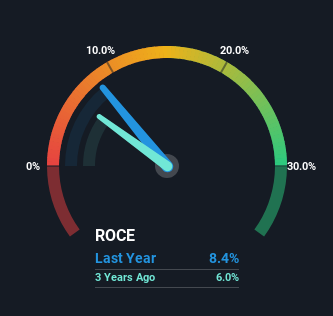Capital Allocation Trends At Macquarie Technology Group (ASX:MAQ) Aren't Ideal
What trends should we look for it we want to identify stocks that can multiply in value over the long term? Firstly, we'll want to see a proven return on capital employed (ROCE) that is increasing, and secondly, an expanding base of capital employed. Ultimately, this demonstrates that it's a business that is reinvesting profits at increasing rates of return. However, after investigating Macquarie Technology Group (ASX:MAQ), we don't think it's current trends fit the mold of a multi-bagger.
Understanding Return On Capital Employed (ROCE)
For those who don't know, ROCE is a measure of a company's yearly pre-tax profit (its return), relative to the capital employed in the business. To calculate this metric for Macquarie Technology Group, this is the formula:
Return on Capital Employed = Earnings Before Interest and Tax (EBIT) ÷ (Total Assets - Current Liabilities)
0.084 = AU$51m ÷ (AU$690m - AU$85m) (Based on the trailing twelve months to June 2024).
Thus, Macquarie Technology Group has an ROCE of 8.4%. Even though it's in line with the industry average of 7.9%, it's still a low return by itself.
View our latest analysis for Macquarie Technology Group

Above you can see how the current ROCE for Macquarie Technology Group compares to its prior returns on capital, but there's only so much you can tell from the past. If you'd like, you can check out the forecasts from the analysts covering Macquarie Technology Group for free.
What Does the ROCE Trend For Macquarie Technology Group Tell Us?
We weren't thrilled with the trend because Macquarie Technology Group's ROCE has reduced by 58% over the last five years, while the business employed 411% more capital. Usually this isn't ideal, but given Macquarie Technology Group conducted a capital raising before their most recent earnings announcement, that would've likely contributed, at least partially, to the increased capital employed figure. The funds raised likely haven't been put to work yet so it's worth watching what happens in the future with Macquarie Technology Group's earnings and if they change as a result from the capital raise.
On a related note, Macquarie Technology Group has decreased its current liabilities to 12% of total assets. That could partly explain why the ROCE has dropped. What's more, this can reduce some aspects of risk to the business because now the company's suppliers or short-term creditors are funding less of its operations. Some would claim this reduces the business' efficiency at generating ROCE since it is now funding more of the operations with its own money.
Our Take On Macquarie Technology Group's ROCE
In summary, Macquarie Technology Group is reinvesting funds back into the business for growth but unfortunately it looks like sales haven't increased much just yet. Investors must think there's better things to come because the stock has knocked it out of the park, delivering a 256% gain to shareholders who have held over the last five years. However, unless these underlying trends turn more positive, we wouldn't get our hopes up too high.
Macquarie Technology Group does have some risks, we noticed 2 warning signs (and 1 which is significant) we think you should know about.
For those who like to invest in solid companies, check out this free list of companies with solid balance sheets and high returns on equity.
New: Manage All Your Stock Portfolios in One Place
We've created the ultimate portfolio companion for stock investors, and it's free.
• Connect an unlimited number of Portfolios and see your total in one currency
• Be alerted to new Warning Signs or Risks via email or mobile
• Track the Fair Value of your stocks
Have feedback on this article? Concerned about the content? Get in touch with us directly. Alternatively, email editorial-team (at) simplywallst.com.
This article by Simply Wall St is general in nature. We provide commentary based on historical data and analyst forecasts only using an unbiased methodology and our articles are not intended to be financial advice. It does not constitute a recommendation to buy or sell any stock, and does not take account of your objectives, or your financial situation. We aim to bring you long-term focused analysis driven by fundamental data. Note that our analysis may not factor in the latest price-sensitive company announcements or qualitative material. Simply Wall St has no position in any stocks mentioned.
About ASX:MAQ
Macquarie Technology Group
Provides telecommunication, cloud computing, cybersecurity, and data center services to corporate and government customers in Australia.
Excellent balance sheet with acceptable track record.
Similar Companies
Market Insights
Community Narratives



